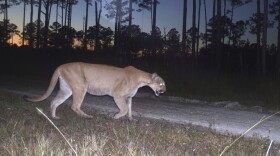-
The seventeenth Florida panther death was reported Friday by the Florida Wildlife Commission. It was the sixteenth big cat death by vehicle impact in 2025.
-
It was the sixth panther killed in Hendry County. Collier leads state with seven.
-
The remains of the 3½-month-old female siblings were found on a road. FWC officials say they believe both died following a vehicle collision.
-
Biologists have shown that an attempt at genetic rescue for the Florida panther 30 years ago has been a success.
-
A land conservancy buys a conservation easement adjacent to AP Ranch, a property with confirmed Florida panther activity. The deal allows the ranch's work to continue while prohibiting development.
-
An endangered Florida panther was found dead after trying to cross busy Interstate 75 in Pasco County, officials said.
-
The death toll of Florida panthers for this year continues to rise after the fourth panther death was recorded on March 10. A total of 36 deaths were recorded in 2024.
-
In 2024, 36 panther deaths were recorded by state wildlife officials, the most since 2016. State statistics show the majority of those deaths resulted from collisions with vehicles including one that was struck by a train.
-
2024 came with a lot of challenges for the Sunshine State, including multiple hurricanes that threatened coastal communities and a contentious presidential election with many local and state seats up for grabs.
-
This is becoming the deadliest year since 2016. More than one out of every 10 known panthers have been killed this year — with most trying to cross highways.
-
The Florida panthers’ numbers dwindled so quickly over the the early 1900s that hunting them was banned in 1958. In 1967, panthers were the first animal to be put on the federal Endangered Species List, and in 1973 the puma, a big cat relative, was named a Florida protected species.
-
As agriculture gives way to planned developments, many worry the Florida panther is on a path to doom. Environmentalists say planned communities — Kingston in eastern Lee and Bellmar in eastern Collier and both the size of small cities — could hurtle the Florida panther from the Endangered Species List to extinction.
Play Live Radio
Next Up:
0:00
0:00
Available On Air Stations










